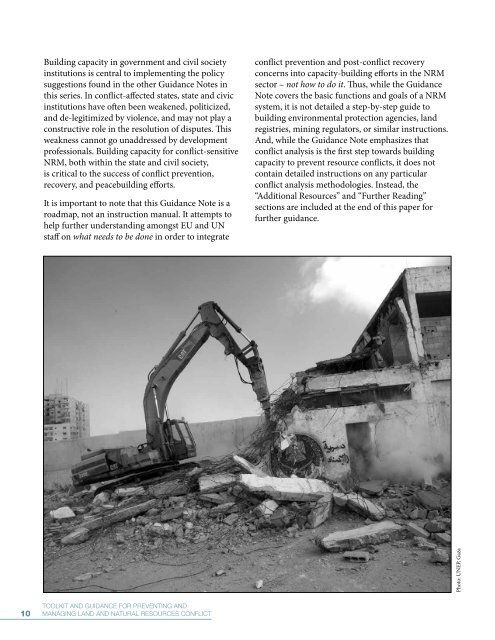Strengthening capacity - Disasters and Conflicts - UNEP
Strengthening capacity - Disasters and Conflicts - UNEP
Strengthening capacity - Disasters and Conflicts - UNEP
You also want an ePaper? Increase the reach of your titles
YUMPU automatically turns print PDFs into web optimized ePapers that Google loves.
Building <strong>capacity</strong> in government <strong>and</strong> civil society<br />
institutions is central to implementing the policy<br />
suggestions found in the other Guidance Notes in<br />
this series. In conflict-affected states, state <strong>and</strong> civic<br />
institutions have often been weakened, politicized,<br />
<strong>and</strong> de-legitimized by violence, <strong>and</strong> may not play a<br />
constructive role in the resolution of disputes. This<br />
weakness cannot go unaddressed by development<br />
professionals. Building <strong>capacity</strong> for conflict-sensitive<br />
NRM, both within the state <strong>and</strong> civil society,<br />
is critical to the success of conflict prevention,<br />
recovery, <strong>and</strong> peacebuilding efforts.<br />
It is important to note that this Guidance Note is a<br />
roadmap, not an instruction manual. It attempts to<br />
help further underst<strong>and</strong>ing amongst EU <strong>and</strong> UN<br />
staff on what needs to be done in order to integrate<br />
conflict prevention <strong>and</strong> post-conflict recovery<br />
concerns into <strong>capacity</strong>-building efforts in the NRM<br />
sector – not how to do it. Thus, while the Guidance<br />
Note covers the basic functions <strong>and</strong> goals of a NRM<br />
system, it is not detailed a step-by-step guide to<br />
building environmental protection agencies, l<strong>and</strong><br />
registries, mining regulators, or similar instructions.<br />
And, while the Guidance Note emphasizes that<br />
conflict analysis is the first step towards building<br />
<strong>capacity</strong> to prevent resource conflicts, it does not<br />
contain detailed instructions on any particular<br />
conflict analysis methodologies. Instead, the<br />
“Additional Resources” <strong>and</strong> “Further Reading”<br />
sections are included at the end of this paper for<br />
further guidance.<br />
Photo: <strong>UNEP</strong>, Gaza<br />
10<br />
TOOLKIT AND GUIDANCE FOR PREVENTING AND<br />
MANAGING LAND AND NATURAL RESOURCES CONFLICT

















